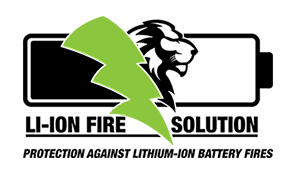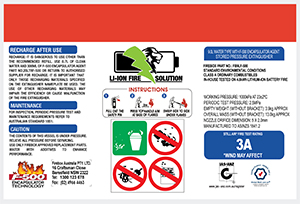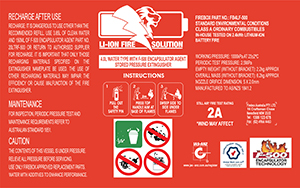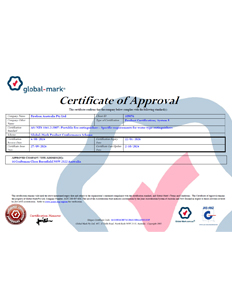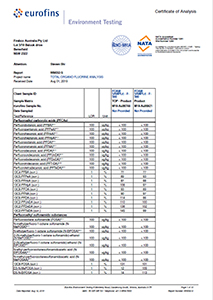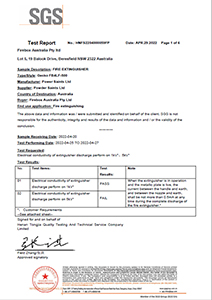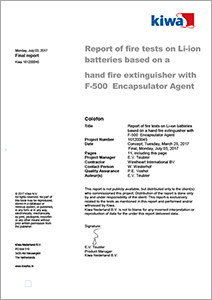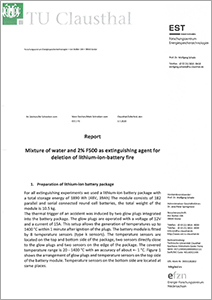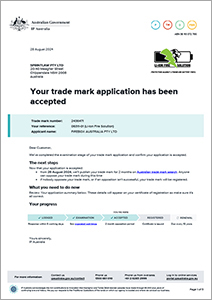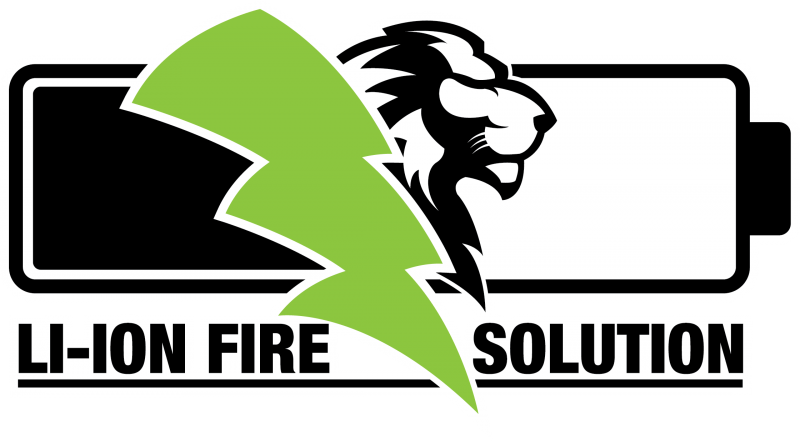
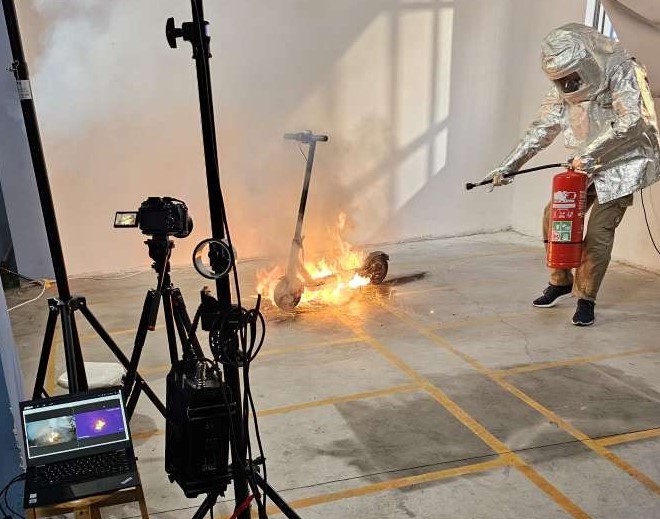
Since 2019, Lithium-Ion Fire Protection, in conjunction with our partners, have been developing solutions for the emerging challenges associated with Lithium-Ion Battery fires.
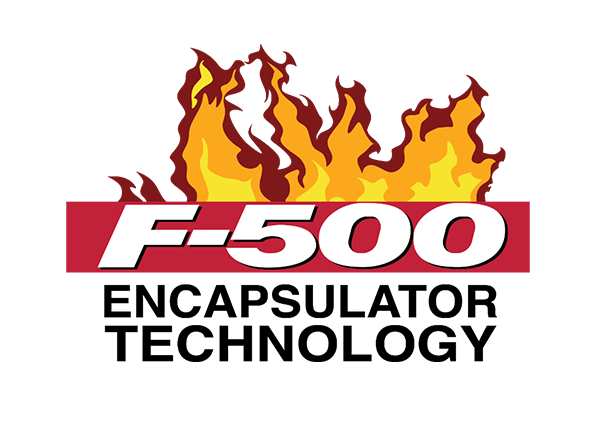
The biggest difference between Lithium and Lithium-Ion batteries is that Lithium batteries feature a single cell construction, meaning that they are single-use and cannot be recharged once empty. On the other hand, lithium-ion batteries can be used time after time, they are rechargeable and can be charged and emptied hundreds of times; hence why they are so popular.
Although lithium-ion batteries might seem much better, especially from a waste point of view, there are still some properties that make lithium batteries incredibly useful. They have a much higher energy density than lithium-ion batteries, meaning they hold more charge in comparison to their size. Lithium batteries can provide power from a single charge, even if it’s the only charge they’ll ever have.
Unfortunately, there is no safe or effective way to recharge lithium batteries, which is why lithium-ion batteries were invented in the first place. Additionally, lithium batteries are cheaper and easier to manufacture, and don’t degrade as quickly as a lithium-ion battery, making them a suitable choice in products such as smoke alarms, watches, pacemakers, calculators to name a few.
Ultimately, both Lithium and Lithium-Ion batteries pack a lot of punch for their size, comparatively against other battery types, making them an incredibly popular option in a huge array of uses. And even more so where products need to be recharged frequently, such as phones, laptops, power backups, vehicles, boats, solar storage systems, industrial equipment, power tools, e-scooters and e-bikes, and so much more.
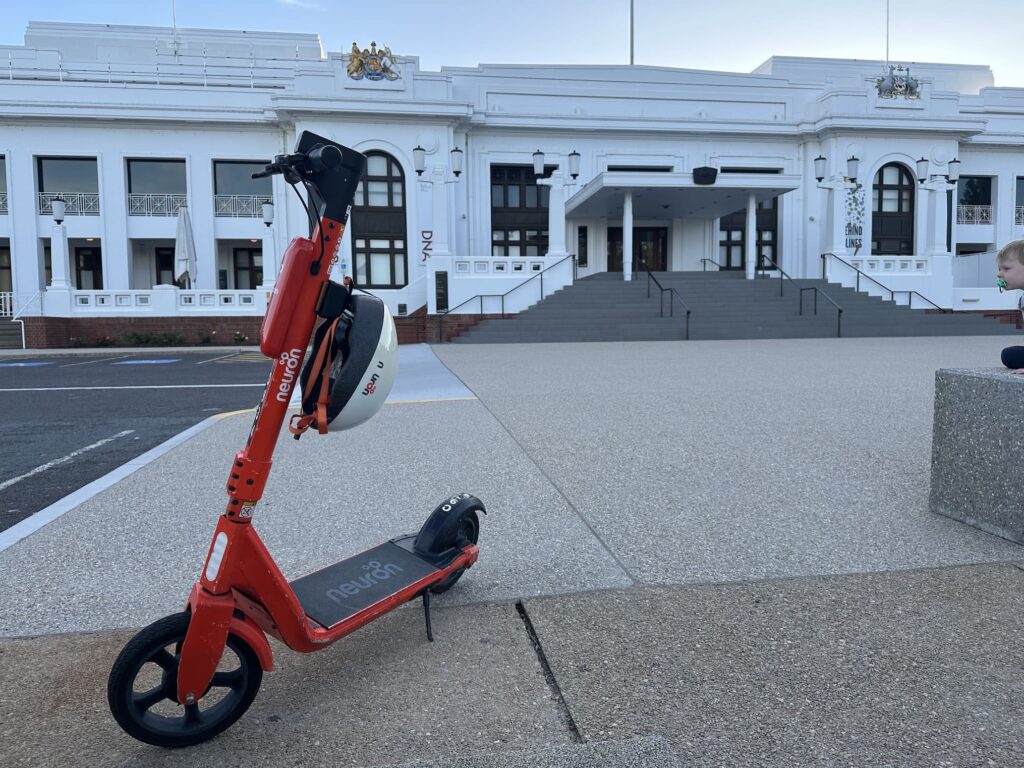
What products commonly contain lithium-ion batteries?
Lithium-Ion batteries are widely used in electronic devices, including Tablets, Mobile Phones, Laptops, Power Tools, Electric/Hybrid Vehicles, Caravans/Motorhomes, Marine Vessels, Emergency Lights, Public Transport, Mining Vehicles & Solar System Batteries, etc.
Lithium-Ion Batteries; why do they catch fire?
Referencing Fire + Rescue NSWYs website (https://www.fire.nsw.gov.au/page.php?id=9389): “Lithium-ion batteries are highly energy-dense and contain electrolytes that are highly flammable. There are several situations that can lead to lithium-ion batteries catching fire, including:
- Overcharging or use of non-compliant charging equipment
- Overheating or exposure to heat or extreme temperatures
- Physical abuse (e.g. dropping, crushing, piercing, and/or vibrations)
- Short-circuiting, battery cell malfunctions or system faults
- Defects or contamination introduced during manufacture
When lithium-ion batteries fail they can undergo thermal runaway. This involves violent bursting of one or multiple battery cells, hissing and release of toxic, flammable and explosive gases, and an intense, self-sustaining fire that can be difficult to extinguish.”
How the 9L Lithium-ion Extinguisher Performs
Where do Firebox come into this? And who is Li-Ion Fire Solution?
Firebox Australia have been manufacturing Portable and Mobile Extinguishers and other fire safety equipment for the Australian market for over 20 years. Since April 2019, Firebox have been working with F-500 Encapsulator Agent (EA) as a water additive to a custom-made extinguisher which has been extensively tested in putting out lithium-ion battery fires without re-ignition.
Recognising that industries need more than just portable extinguishers to help provide protection against Lithium-Ion battery fire risks, we developed our new brand, Li-Ion Fire Solution, to be a brand that offers a broad-spectrum approach to Lithium-Ion battery fires. So, when you see Li-Ion Fire Solution out there, you can trust its performance knowing that it has been rigorously tested for use on Lithium-Ion battery fires.
Where do Firebox come into this? And who is Li-Ion Fire Solution?
Our 4L and 9L fire extinguishers have been certified by Global Mark Australia, who are a JAS-ANZ accredited certifying body. The FB4LF-500 model has achieved a 2A rating as per AS1850 and the FB9LF-500 model has achieved a 3A rating as per AS1850. Being certified as a water-type extinguisher means we can only display an A-Rating, yet both of these extinguishers have performed well on Class B (combustible fuel), and Class F (cooking oil and animal fat) Fires.
BSI Australia (Firebox Australia’s certifying body from 2006 to 2024, before transitioning to GlobalMark for extinguisher certification from 2024 onwards) also witnessed the performance of both the 4L and 9L F-500EA fire extinguishers on lithium-ion battery fires, confirming the results as described. However, as there is currently no Australian Standard specifically for testing fire extinguishers against lithium-ion battery fires, these units cannot be claimed as “approved” for such applications. Supporting documentation from BSI is available upon request.
The Consumer Goods (Portable Non-aerosol Fire Extinguishers) Safety Standard 2021 sets out requirements for portable non-aerosol fire extinguishers, the current Mandatory Australian Standard for portable Non-aerosol Fire Extinguishers.
The mandatory standard is based on certain sections of the voluntary Australian New Zealand standard AS/NZS 1841.1:2007 Portable fire extinguishers and AS/NZS 1841.2 to 8:2007, where they apply to the fire extinguisher.
The 4L and 9L Lithium-ion Fire Solution™ fire extinguishers supplied by Firebox Australia meet the requirements of the Mandatory Australian Standard for portable non-aerosol fire extinguishers. They are certified by Global Mark Australia* to AS/NZS 1841.2-2007 as water-type fire extinguishers. Which are also ActivFire listed. *
Do the Li-Ion Fire F-500EA Extinguishers comply with Australian Standards?
- Currently, there is no Australian Standard for Lithium-Ion battery fires. However, our 4L and 9L F-500EA fire extinguishers meet the Australian Standard AS/NZS1841.2 – 2007, which is the current mandatory Australian Standard for Water-type fire extinguishers.
- We have conducted multiple tests on Lithium-Ion battery fires, which BSI Australia have witnessed. Our 4L F-500EA fire extinguisher has successfully extinguished a 2.4kWh lithium-ion battery fire, without reignition. Our 9L F-500EA fire extinguisher has successfully extinguished a 4.8KWh lithium-ion battery fire, without reignition.
- F-500EA solution has been tested extensively by independent, testing organisations, including Kiwa, Dekra, Daimler, Dutech, Bosch, Fraunhofer University, TU Clausthal, and multiple other research facilities. These testings have been controlled, scientific and highly instrumented, documenting fire suppression, control and elimination of thermal runaway and encapsulation of both flammable electrolyte and other explosive off-gases, rendering them nonexplosive. Many of those testing results found that the F-500 Encapsulator Agent is the most effective agent on lithium-ion battery fires compared to traditional firefighting agents, including plain water, foam, dry chemical powder or CO2 type.
- F-500EA solution is UL Listed for use on Class A and B fires.
- Encapsulator Agent is listed in the new NFPA 18A standard Section 7.7 and Annex 4.3.
Does the Li-Ion Fire F-500EA Extinguisher range contain PFAS or other toxins?
The Li-Ion Fire F-500EA Solution is fluorine free, non-corrosive, non-toxic, non-hazardous, and fully biodegradable. The TOFA test report (Link Provided), which details the clean nature of F-500EA. We have developed a Safety Data Sheet (SDS) which can be downloaded as well.
Can I use an ABE Extinguisher on a Lithium-Ion battery fire?
You can use an ABE Extinguisher on a Lithium-Ion battery fire. It will help control the spread of the fire to other fuel sources nearby, but it will fail to stop reignition and the thermal runaway. Please see the video below which compares the performance of ABE vs Foam vs F-500EA on a Lithium-Ion battery fire.
Lithium Ion Battery Fire Testing
How does F-500EA work differently to an ABE Powder or Foam type fire extinguisher on Lithium-ion battery fires?
Lithium-ion batteries burn at an extremely high temperature. The key to stopping a lithium-ion battery fire is to quickly remove the heat and stop the reaction of the electrode material with other components of the battery. F-500EA provides a perfect solution for both of those scenarios as it rapidly cools by absorbing heat and disrupts the free radical process or thermal runaway reaction by surrounding flammable electrolyte material.
Most foam or powder type fire extinguishers only work for “2D fires”, which can only be applied to a flat surface as the extinguishant has no ability to adhere to vertical or other angular surfaces. The F-500EA agent can penetrate inside the structure of a battery, thus being able to successfully extinguish this type of fire.
Encapsulator Agent - How it works
Encapsulator Agent - How it works
F-500 EA fire suppression agents work by encapsulating flammable fuels, interrupting the chemical chain reaction of combustion, and rapidly reducing heat. This unique approach allows it to effectively extinguish various types of fires, including lithium-ion battery fires, and reduces the risk of re-ignition and toxic smoke emissions.
- Encapsulation: F-500 EA molecules form a protective “skin” around water droplets and fuel molecules, creating a micelle or chemical cocoon. This encapsulation prevents the release of flammable vapors, which are a major contributor to fire reignition.
- Rapid Heat Reduction: The encapsulated water droplets absorb heat more efficiently than plain water, reducing the temperature of the fire and surrounding surfaces. This rapid cooling is crucial for controlling lithium-ion fires, as they can rapidly escalate to thermal runaway.
- Free Radical Interruption: F-500 EA interrupts the free radical chain reaction that fuels combustion, effectively stopping the fire’s chemical reaction. This leads to reduced soot and smoke toxicity.
- Increased Wetting and Penetration: F-500 EA reduces the surface tension of water, allowing it to penetrate deeper into solid fuels and enhance its cooling and wetting effects.
- Enhanced Cooling: F-500 EA absorbs more heat than water, reducing the amount of steam released and providing a more effective cooling effect.
- Prevention of Re-ignition: By encapsulating the fuel, F-500 EA prevents the release of flammable vapors, minimizing the risk of re-ignition.
In summary, F-500 EA’s unique encapsulation technology, rapid heat reduction, and disruption of the combustion chain reaction make it a powerful and versatile fire suppression agent.
Why would I choose the F-500EA Extinguisher over other types of fire extinguishers?
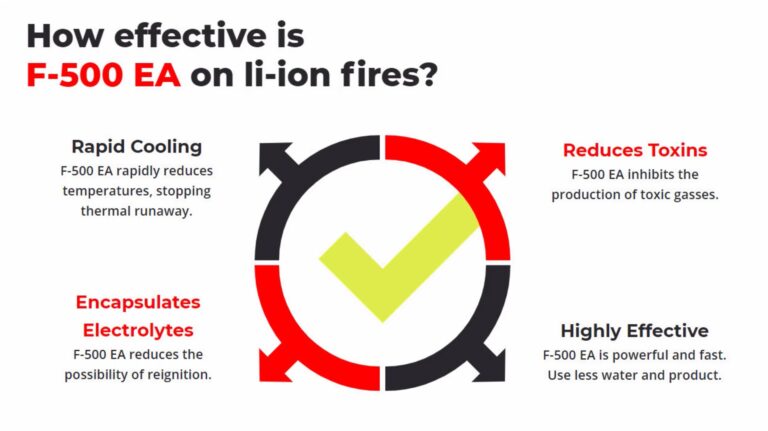
The advantages of using the F-500EA fire extinguisher vs other fire extinguishers are listed below:
- Rapid Cooling
- Interrupts Free Radical Chain Reaction
- Drastic Toxin & Smoke Reduction
- No Fluorinated Ingredients (PFOA/PFAS)
- 3D fires (a term used to describe a fire that is not simply burning on a flat surface)
- Enhanced Burn Back Resistance
- Tested Worldwide to put out lithium-ion battery fires
Are there any products in the Li-Ion fire range to cover larger risks?
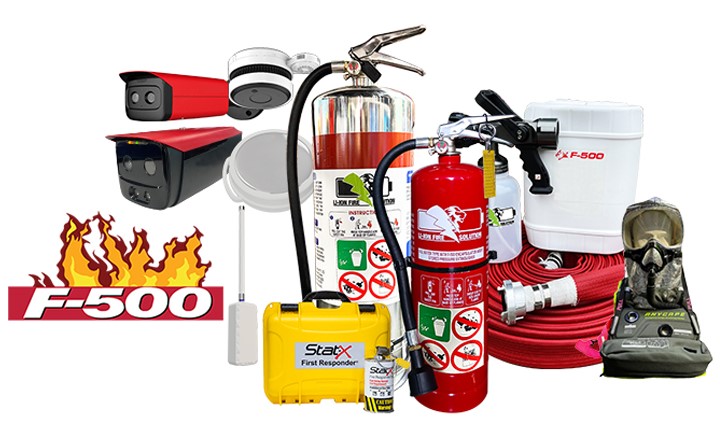
- 45L & 90L F-500EA wheeled-type fire extinguishers.
- TKO (Total Knock Out) nozzles and quick response gears.
- Fire hydrant and Fire hose reel setups.
- Electric Vehicle Water Mist Spraying System.
- Li-ion battery storage and recharge cabinets.
- Fire Suppression systems.
- Thermal & Flame detection cameras.
- Early detection system for battery energy storage systems(BESS).
Is the Li-Ion Fire F-500EA Extinguisher range compliant in New Zealand?
Both 4L and 9L Li-Ion Fire F-500EA Extinguishers are approved for use in Australia and New Zealand as per AS/NZS 1841.2:2007. Both of these extinguishers have a relevant FERN number for the New Zealand Market. This approval only applies to the extinguishers being used a water-type extinguisher.
Can you use Li-ion Fire Solution™ Fire Extinguisher on a lithium-ion battery when it’s on charge?
DO NOT discharge the Li-ion Fire Solution™ 4 Litre or 9 Litre Fire extinguisher onto an electrical system. Being a water-type extinguisher, you should only use this product when there is a fire. Do not point it directly at an active AC Power source, such as switchboards.
If the fire is located on an electrical source such as previously described, then a
DCP or CO2 extinguisher is best. Whilst a Lithium-Ion battery holds an electrical charge, our F-500EA is safe to use on a battery if not connected to an active charging point.
Caution is always to be used with any type of fire extinguisher.
Li-ion Fire Solution™ F-500EA fire extinguishers have been tested according to the requirements of the EN3-7 standard, specifically Clause 9. They comply with EN3 specifications for use on electrical systems (up to 1000V, with a minimum distance of 1 meter).
It is safe to use the Li-ion Fire Solution™ Fire Extinguisher on lithium-ion battery fires for two main reasons:
- Li-ion Fire Solution™ Fire Extinguishers are equipped with water mist nozzles, which discharge water in a mist form instead of a stream.
- When mixed with water, F-500EA reduces the water’s surface tension, further decreasing the size of the water droplets. This not only enhances the cooling effect but also reduces electrical conductivity.
In April 2022, SGS Laboratory conducted testing on an F-500EA water-type extinguisher (Ref: HNFS2204000059FP), which produces a fine water mist.
Result: Passed electrical conductivity test at 1kV.*
During discharge, current between any live metal part and earth remained below 0.5mA, confirming high dielectric strength and non-conductivity under typical firefighting conditions.
F-500EA is considered safe to use near live electrical equipment up to 5,000V, provided standard precautions are followed:Maintain safe spray distance (≥1 metre)
- Use appropriate nozzles
- De-energize power where possible
To better understan the credibility of your solution, have you conducted any third party testing reports involving the use of F-500EA on lithium-ion battery fires?
F-500EA solution has been tested extensively by independent testing organisations, including Kiwa, Dekra, Daimler, Dutech, Bosch, Fraunhofer University, TU Clausthal, and multiple other research facilities. These testings have been controlled, scientific and highly instrumented, documenting fire suppression, control and elimination of thermal runaway and encapsulation of both flammable electrolyte and other explosive off-gases, rendering them nonexplosive. Many of those testing results found that F-500EA is the most effective agent on lithium-ion battery fires compared to traditional firefighting agents, including plain water, foam, dry chemical powder or CO2 type.
KIWA-Report-161200045-Fire-Tests-Li-Ion-Batteries-F-500-EA. Kiwa Netherlands B.V. lithium-ion battery testing concludes F-500 Encapsulator Agent is the most effective agent on lithium-ion battery fires when tested against foam and dry chemical fire extinguishing agents.
Test Report on the Extinguishing of a Lithium-ion Battery TU Clausthal University_2020. TU Clausthal lithium-ion battery testing in Clausthal-Zellerfeld, Germany concludes that using a 2% solution of F-500 Encapsulator Agent to extinguish a lithium-ion battery fire is significantly superior to using plain water.
TR_F5_AM_Fraunhofer HHI Lithium-ion Battery Fire Extinguishment Testing. Fraunhofer Institute for Telecommunication and Heinrich Hertz Institute, HHI conduct a sprinkler testing series on F-500 Encapsulator Agent for lithium-ion battery fire suppression.
Fire extinguishing test Newcastle University March 2022. The original webinar video is available online, and demonstrates controlled-field testing of multiple agents on lithium-ion battery fires, including F-500EA.
The extinguishment mechanisms of a micelle encapsulator F-500EA on LIB v2 Beijing Institute of Technology. The State Key Laboratory of Explosion Science and Technology, Beijing Institute of Technology and the Department of Engineering Physics at Tsinghua University in Beijing, China, published an investigation on extinguishment mechanisms of a spherical micelle and the effectiveness of F-500EA on lithium-ion battery fires.
Comparison of Fire Suppression Techniques on Lithium Ion Battery. US Government work found that the F-500EA water additive is the most effective agent against other agents.
Research Development of Fire Extinguishing Technology for Lithium-ion Batteries Nanjing Tech University. The College of Safety Science and Engineering, Nanjing Tech University, in Nanjing, China, publishes an abstract for the 8th International Conference on Fire Science and Fire Protection Engineering summarizing previous experimental studies on lithium-ion battery fire suppression using F-500EA.
Are there any countries that have an established, approved fire extinguisher standard specifically for lithium-ion battery fires? Also, is there a particular region or country currently leading the global market in terms of adopting and regulating this type of fire protection?
NTA 8133 Report: KIWA Report 202 NTA-8133 Neuruppin F-500
In 2021, the F-500 Encapsulator Agent (F-500 EA) successfully completed several testing trials to achieve the Dutch NTA 8133 Report (Neuruppin branded F-500EA fire extinguisher). NTA 8133 Report is the first international report that deals with lithium-ion batteries with a limited capacity of up to 600 Wh. This includes electronics like smartphones, laptops, power tools, household appliances, medical equipment, drones, e-bikes, etc. Only fire extinguishers meeting these requirements, such as F-500 EA, may use the NTA 8133 marking.
The video below mirrors the aforementioned steps of testing, which demonstrates F-500EA’s effectiveness on lithium-ion battery fires in a controlled environment.
Performance tests on F-500EA:
Since 2019, Firebox Australia, in conjunction with our partners, have been developing solutions for the emerging challenges associated with Lithium-Ion Battery fires.
Currently, there is no Australian Standard for Lithium-Ion battery fires, Firebox Australia have conducted multiple tests on Lithium-Ion battery fires, which BSI Australia have witnessed. Our 4L F-500EA fire extinguisher has successfully extinguished a 2.4kWh Lithium-ion battery fire. Our 9L F-500EA fire extinguisher has successfully extinguished a 4.8Wh Lithium-ion battery fire, without reignition.
What makes these F-500EA Extinguisher effective?
Lithium-Ion Best Practices
The multipurpose formula found in our extinguishers is packed with Encapsulator Agent (EA) molecules, which consist of a hydrophilic polar head (which loves water and dissolves in water) and a hydrophobic non-polar tail (which fears water and will do anything to get away from water). Once these EA molecules enter the water, they instantly and automatically orient with the non-polar tails inward and the polar heads outward, forming millions of spherical micelles.
When these micelles exit the nozzle as the extinguisher is activated, they form F-500EA droplets. As each droplet is formed, the micelles nearest to the surface of the droplet automatically break apart. The F-500 EA molecule non-polar tails stick out of the droplet, pulling the polar heads to the surface. This forms a protective F-500EA skin on each droplet. Instead of making bubbles, this changes the chemical makeup of the water droplet and is how it cools and extinguishes fire.
When the F-500EA extinguisher is activated, it releases a fine mist (not a stream like a traditional water-type fire extinguisher). The non-polar tails on the surface of the EA droplet rapidly absorb heat and drive it inside to where the micelles and water are. Through this process, the heat is slowly absorbed into the water that surrounds each micelle, stopping it from creating steam.
This unique technology enables F-500EA fire extinguishers to effectively extinguish Class A, B, F, and Lithium-ion battery fires, all of which have been tested by Firebox to be effective on and witnessed by BSI. In fact, we were able to obtain a 3A, 10B, 4F rating for our 9L F-500EA Fire Extinguisher, however we only advertise the 3A performance in line with a water-type fire extinguisher.
What inspired the name and concept of Li-Ion Fire?
Trademark Ref: IP Australia #2436471
Li-Ion Fire Solution™ was created in response to the growing global need for fire safety solutions specific to lithium-ion battery and renewable energy risks. As a specialist brand—not a generalist—we focus solely on this emerging hazard, delivering targeted prevention, detection, and suppression products.
Backed by our trademark and supported by an online resource centre, our mission is to empower safer energy use through innovation, education, and world-class protection. We aim to become the global benchmark in lithium-ion fire safety, trusted by industry professionals and emergency responders alike.
